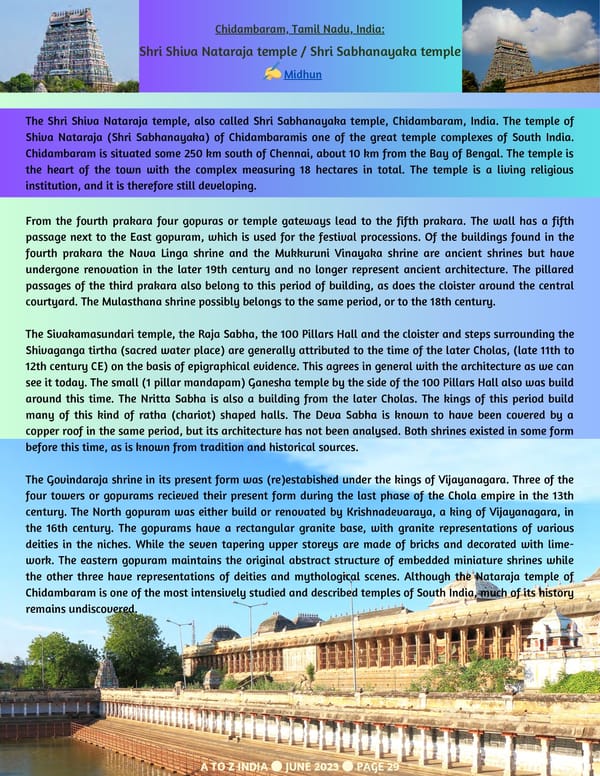Chidambaram, Tamil Nadu, India: Shri Shiva Nataraja temple / Shri Sabhanayaka temple Midhun The Shri Shiva Nataraja temple, also called Shri Sabhanayaka temple, Chidambaram, India. The temple of Shiva Nataraja (Shri Sabhanayaka) of Chidambaramis one of the great temple complexes of South India. Chidambaram is situated some 250 km south of Chennai, about 10 km from the Bay of Bengal. The temple is the heart of the town with the complex measuring 18 hectares in total. The temple is a living religious institution, and it is therefore still developing. From the fourth prakara four gopuras or temple gateways lead to the fifth prakara. The wall has a fifth passage next to the East gopuram, which is used for the festival processions. Of the buildings found in the fourth prakara the Nava Linga shrine and the Mukkuruni Vinayaka shrine are ancient shrines but have undergone renovation in the later 19th century and no longer represent ancient architecture. The pillared passages of the third prakara also belong to this period of building, as does the cloister around the central courtyard. The Mulasthana shrine possibly belongs to the same period, or to the 18th century. The Sivakamasundari temple, the Raja Sabha, the 100 Pillars Hall and the cloister and steps surrounding the Shivaganga tirtha (sacred water place) are generally attributed to the time of the later Cholas, (late 11th to 12th century CE) on the basis of epigraphical evidence. This agrees in general with the architecture as we can see it today. The small (1 pillar mandapam) Ganesha temple by the side of the 100 Pillars Hall also was build around this time. The Nritta Sabha is also a building from the later Cholas. The kings of this period build many of this kind of ratha (chariot) shaped halls. The Deva Sabha is known to have been covered by a copper roof in the same period, but its architecture has not been analysed. Both shrines existed in some form before this time, as is known from tradition and historical sources. The Govindaraja shrine in its present form was (re)estabished under the kings of Vijayanagara. Three of the four towers or gopurams recieved their present form during the last phase of the Chola empire in the 13th century. The North gopuram was either build or renovated by Krishnadevaraya, a king of Vijayanagara, in the 16th century. The gopurams have a rectangular granite base, with granite representations of various deities in the niches. While the seven tapering upper storeys are made of bricks and decorated with lime- work. The eastern gopuram maintains the original abstract structure of embedded miniature shrines while the other three have representations of deities and mythological scenes. Although the Nataraja temple of Chidambaram is one of the most intensively studied and described temples of South India, much of its history remains undiscovered. A TO Z INDIA ● JUNE 2023 ● PAGE 29
 A TO Z INDIA - JUNE 2023 Page 28 Page 30
A TO Z INDIA - JUNE 2023 Page 28 Page 30